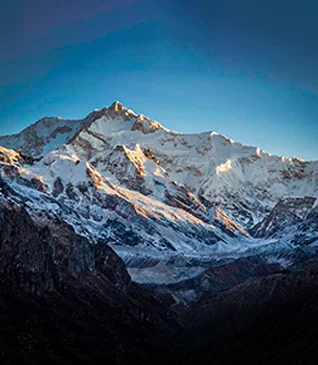Nepal is a beautiful mountain country filled with towering peaks and mesmerizing landscapes. Among the many popular treks in Nepal, the Mera Peak Expedition often goes unseen and is quite a beautiful offbeat option. The Mera Peak stands at an altitude of 6,476m and is one of the tallest peaks in Nepal that does not require technical climbing skills. At over 6000 m this peak tests your mental and physical resilience and fulfills your adventure dreams of climbing a Himalayan peak. Get to witness the beauty of Nepal, its mountains, the Sherpa culture, and the friendliness of the locals in this wonderful adventure.
In this article, we are sharing reasons why we think Mera Peak should be on your 2025 trekking bucket list.
Here’s why we love the Mera Peak Expedition
-
It is an Accessible High-Altitude Adventure
.webp)
At 6,476m (21,247 ft) Mera Peak presents an exhilarating yet attainable challenge for trekkers and mountaineers. Unlike some other peaks in the region, Mera Peak doesn't require extensive technical climbing skills, making it accessible to a broader range of enthusiasts.
-
Impeccable Himalayan Panorama
.webp)
From the summit of Mera Peak Expedition, trekkers are treated to unparalleled views of the world's highest peaks, including Mt. Everest, Cho-Oyu, Lhotse, Makalu, and Kanchenjunga, among others. The sight of these majestic giants towering above the clouds is a moment of pure awe and inspiration.
-
The Cultural Immersion
.webp)
The journey to Mera Peak begins in Kathmandu, Nepal's vibrant capital city, where trekkers can immerse themselves in the rich cultural heritage of the region. From exploring ancient temples to sampling diverse cuisine, Kathmandu offers a glimpse into the heart and soul of Nepal.
-
Varied Landscape and Terrain
.webp)
The trek to Mera Peak takes you through a diverse range of landscapes, from lush forests and rhododendron groves to alpine meadows and high-altitude glaciers. Each day brings new challenges and breathtaking scenery, ensuring an unforgettable adventure.
-
The local hospitality of the Sherpa community
.webp)
Along the trekking route, trekkers have the opportunity to interact with local Sherpa communities and experience their warm hospitality. Tea houses dot the trail, offering cozy accommodations and hearty meals, providing a welcome respite after a day of trekking.
-
Test your limits
Summiting Mera Peak is a significant personal achievement and a testament to one's determination, perseverance, and physical fitness. The sense of accomplishment and fulfillment upon reaching the summit is unparalleled and stays with trekkers for a lifetime.
Best Time to do Mera Peak Trek
The best times to trek to Mera Peak in Nepal are spring (April to June) and autumn (September to November).
Spring
-
The weather is stable and clear, perfect for trekking.
-
The trails burst with colorful rhododendron flowers, making the scenery breathtaking.
-
Days are comfortable, but it can get cold at night, especially at higher altitudes.
-
You'll have fantastic views of Mera Peak and other mountains.
Autumn
-
Clear skies and stable weather make it an excellent time for trekking.
-
The temperatures are pleasant, with warm days and cool nights.
-
The landscape is lush and vibrant from the monsoon rains, creating stunning scenery.
-
Many people choose this season for peak climbing because the conditions are ideal.
-
Plus, you'll get to experience local festivals and immerse yourself in Nepalese culture.
Both seasons offer unique experiences and incredible views, so you can't go wrong with either choice!
So, if you are looking for an offbeat adventure, think about giving Mera Peak a try! It's an amazing choice! The scenery you'll see along the way is absolutely breathtaking. From lush forests to sparkling glaciers, the Himalayas will blow you away with their beauty. Climbing Mera Peak might push you to your limits, but remember, overcoming challenges makes success even sweeter.





.webp)










.webp)


